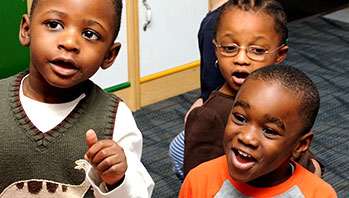- 2 small pieces of a sentence strip for word cards, one labeled sea and the other see
MA Standards:
Speaking and Listening/SL.PK.MA.1a: Observe and use appropriate ways of interacting in a group (e.g. taking turns in talking, listening to peers, waiting to speak until another person is finished talking, asking questions and waiting for an answer, gaining the floor in appropriate ways).
Literature/RL.PK.MA.8.a: Respond with movement or clapping to a regular beat in poetry or song.
Head Start Outcomes:
Social Emotional Development/Self-Regulation: Follows simple rules, routines, and directions.
Language Development/Receptive Language: Attends to language during conversations, songs, stories, or other learning experiences.
PreK Learning Guidelines:
English Language Arts/Language 1: Observe and use appropriate ways of interacting in a group (taking turns in talking; listening to peers; waiting until someone is finished; asking questions and waiting for an answer; gaining the floor in appropriate ways).
English Language Arts/Reading and Literature 12: Listen to, recite, sing, and dramatize a variety of age-appropriate literature.
English Language Arts/Reading and Literature 8: Listen to, identify, and manipulate language sounds to develop auditory discrimination and phonemic awareness.
EEC Infant and Toddler Guidelines:
PW50.: The older toddler engages in a variety of physical activities.
Recite Together: “A Sailor Went to Sea”

© Commonwealth of Massachusetts, Department of Early Education and Care (Jennifer Waddell photographer). All rights reserved.
ELA Focus Skills: Phonological Awareness (Rhyme, Rhythm, and Repetition; Clapping to Beat), Hand-Eye Coordination, Listening and Speaking, Vocabulary
Before doing the activity, you may wish to tell children about the homophones sea and see. Say, Sometimes two words sound alike but mean totally different things. Show children the two word cards and say, These words sound the same: /s/ /ē/. But s-e-a (point to it) means “ocean” and s-e-e (point to it) means “look at.” Both meanings are in a clapping rhyme we will learn.
Ask a volunteer to be your partner. Recite the chant and do the hand-clapping with your partner. The clapping of beats, or syllables, becomes easier by the third verse. Then ask each child to choose a partner and do the hand-clapping rhyme.
A Sailor Went to Sea
A sailor went to sea, sea, sea, (clap hands together on each beat)
To see what he could see, see, see, (clap hands against partner’s on each beat)
But all that he could see, see, see (clap hands together on each beat)
Was the water in the sea, sea, sea. (clap hands against partner’s on each beat)
Verse 2
A toy boat went to sea, sea, sea, (clap hands together on each beat)
To see what it could see, see, see, (clap hands against partner’s on each beat)
And all that it could see, see, see, (clap hands together on each beat)<
Was the water in the sea, sea, sea. (clap hands against partner’s on each beat)
Verse 3
A little boy watched the sea, sea, sea. (clap hands together on each beat)
To see what he could see, see, see, (clap hands against partner’s on each beat)
And happy as could be, be, be. (clap hands together on each beat)
Yelled, “My boat’s come back to me, me, me!” (clap hands against partner’s on each beat)
Adaptation: With very young children, sing the song to one child at a time, one line at a time. If children become frustrated with the partner clapping, have them simply clap their hands together as they sing.
